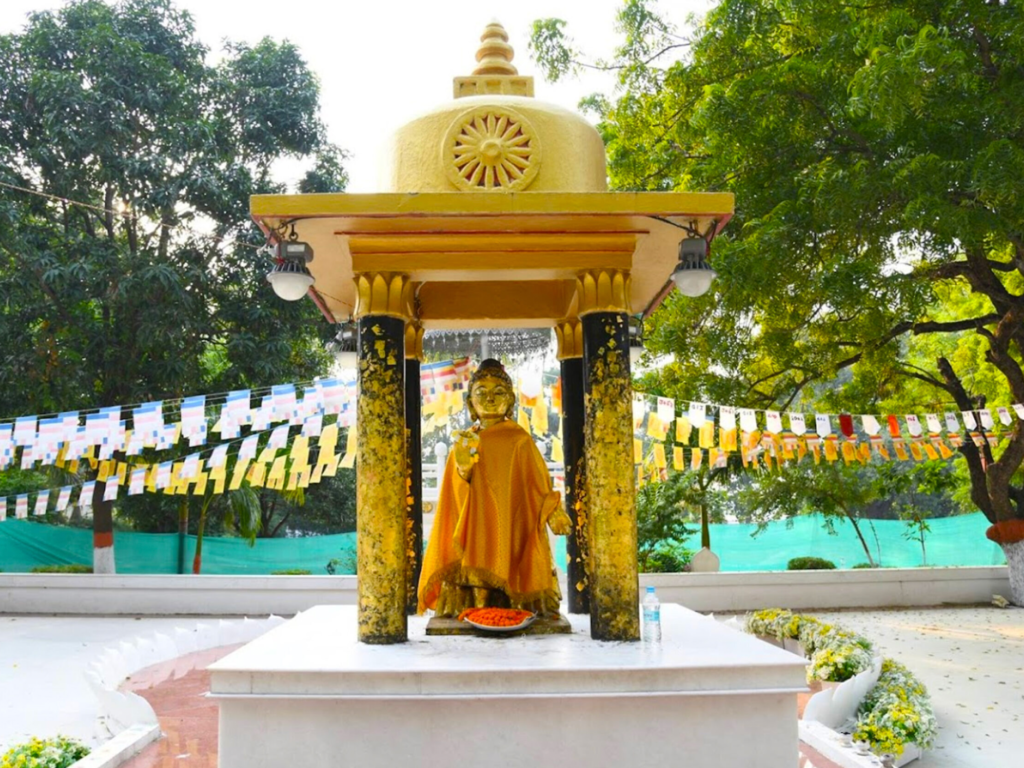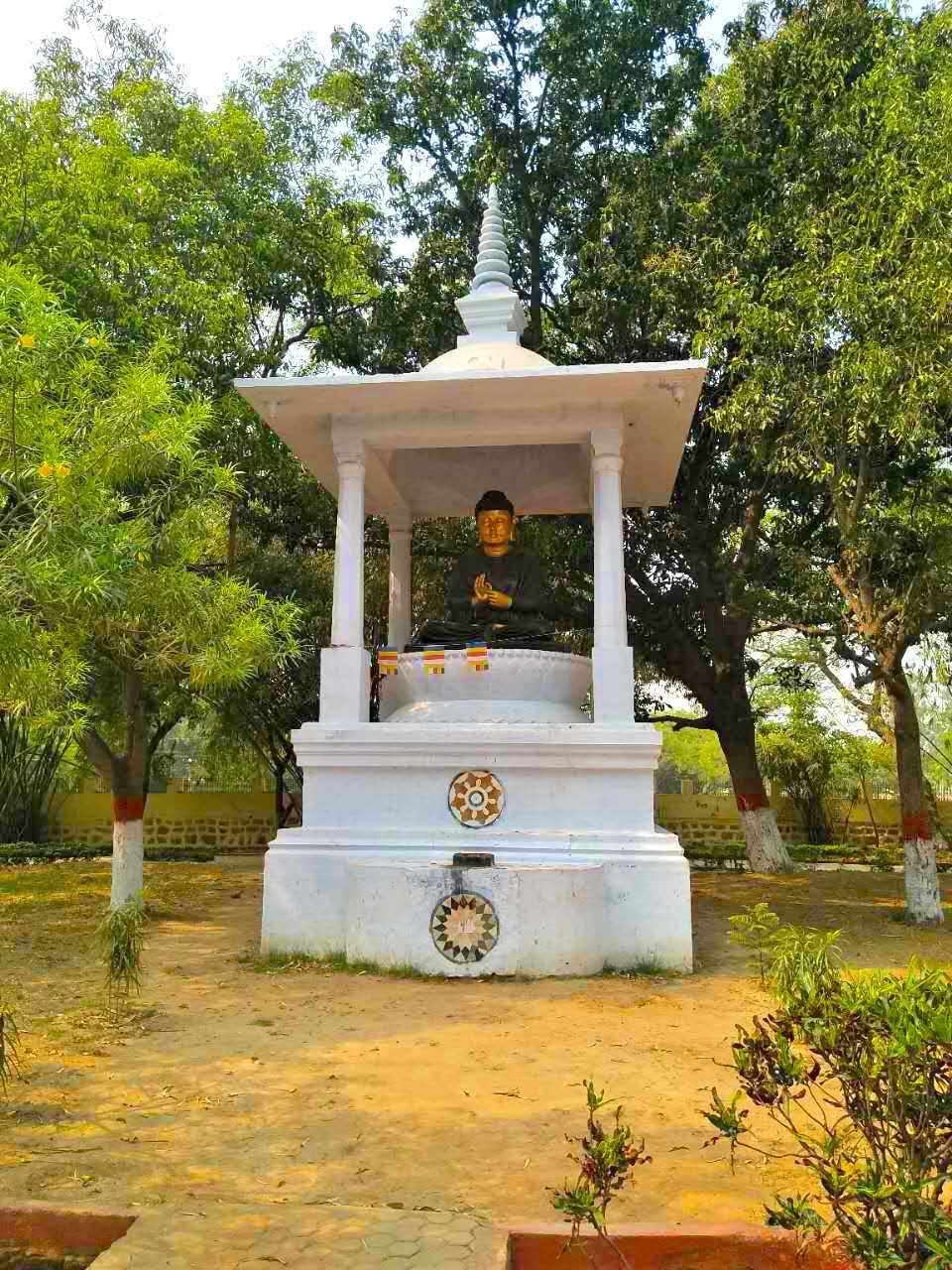Venuvana Vihara
Venuvana Vihara, also known as Venuvana Monastery. A monastery situated in the northern part of Rajagriha in Magadha, India. It was built by King Bimbisara as an offering to Shakyamuni Buddha. According to one account, it was Kalandaka, a wealthy man in Rajagriha, who built the monastery and donated it to the Buddha. According to another account, Kalandaka offered his bamboo grove, and Bimbisara built a monastery there. Bamboo Grove Monastery and Jetavana Monastery in Shravastiwere the two major centers of Shakyamuni’s propagation activities.

In the vicinity of Venuvana is a large pond with a Buddha image at the centre. This pond is believed to be the site of the “Karanda Tank” mentioned in Buddhist text as the ‘Karanda Kanivapa’.

The following is from Nancy’s sharing:
Hi everyone, welcome to this channel, Rising of Bodhisattvas. This is Nancy from International Buddha Dharma Society for Cosmic Law in America. It’s a great honor to be here sharing Pilgrimage trip with you. Today is Nov. 10th, 2020. We will continue our trip. Today, we will visit the Snow Mountain Dragon Cave where the Buddha spent six years practicing asceticism, the Cave of Seven Leaves where the Buddha’s teachings were first collected, and the Kalandaka Venuvana Vihara, the first Buddhist temple in Buddhist history. Now let’s take a look at the Snow Mountain Dragon Cave.
The Snow Mountain Dragon Cave is also called the Dungeshwari Cave, or Mahakala Cave. It’s located in Gaya, so it was actually on the previous day’s trip. It’s not a snow mountain. It’s called Snow Mountain because this mountain looks like a snow mountain in color. Before Prince Siddhartha was enlightened, he spent six years here in this mountain cave. Some said that it was not just one cave, but three. He ate only one rice and one grain a day and at the end he had only skins and bones left. It’s said that there was a poisonous dragon here in the cave and was moved by the Buddha, and became the Buddha’s guardian. The cave is dark and small. There is a statue of the Buddha inside. People line up and get in the cave to pay homage to the Buddha. They would also meditate inside for a while. The energy there is spectacular.
After the Buddha became enlightened, once he talked about the cause of why he had to spend six years practicing asceticism. I will share the cause with you here.
When Kashyapa Buddha lived in the world, there were two very close friends, one named Huxi and one named Huoman. One day, Huxi heard that Kashyapa Buddha was in the city teaching people, he was very happy. He thought that this was a great chance to listen to Dharma. It’s truly rare to meet a Buddha in the world. So he was eager to see the Buddha. He didn’t want his friend to miss the chance. So he went to talk to Huoman, “I have a great news for you. The Buddha is here in the city. We have to see him and pay homage to the Buddha.” However, Huoman was not interested. Huxi waited for three days. He came to ask Huoman to go with him again. But still, Huoman was arrogant and did not want to see the Buddha. Another three days past. Huxi could not wait any more. He came again.
When seeing that Huoman still had the same attitude, he was angry. He walked up, grabbed Huoman, and forced him to go see the Buddha with him. Seeing that Huxi was so serious about this, Huoman thought, “Maybe it is worth to take a look.” So finally after six days was wasted, they went together to see the Buddha. They paid homage to the Buddha. Kashyapa Buddha saw that these two friends could help each other, he praised them and spoke wonderful Dharma to them.
The Buddha said, “Huoman at that time in that life was me. Because of the wasted six days in that life, every life after that, I had six years of confusing until this life. So my disciples, in your daily life, protect well your mind.”
This is the cause of the Buddha’s six years of ascetic practice. Now let’s visit the Cave of Seven Leaves.
The Cave of Seven Leaves is also called Saptaparni Cave, or Sattapani Cave. It’s a mountain cave located about 1-2 miles southwest of Rajagriha.
The Saptaparni Cave is important in the Buddhist tradition, because many believe it to be the site in which the Buddha spent some time before his death, and where the first Buddhist council was held after Buddha entered paranirvana. It was here that a council of few hundred Arhats decided to appoint Ananda to compose the Buddha’s teachings for the future generations. Ananda was the Buddha’s cousin, close disciple and attendant. He was believed to have the best memory and had accompanied the Buddha the most of the time when the Buddha gave sermons in north India. The Buddha never wrote down his teachings. After the Saptaparni Cave meeting, Ananda created an oral tradition of the Buddha’s teaching from his memory, prefacing it with “Thus have I heard”. Upali who was considered the best in upholding precepts was credited with reciting the Nikaya discipline or “rules for the Bhikshus”.
Now let’s visit the Kalandaka Venuvana Vihara.
Kalandaka Venuvana Vihara is the first Buddhist temple in Buddhist history. It’s said that the bamboo grove was offered to the Buddha and his disciples by the Elder Kalandaka when he was moved by the Buddha’s compassion and diligence. Later, King Bimbisara ordered to built the monastery/Vihara to repay the Buddha’s kindness. The monastery was divided into sixteen courts, each court containing sixty dwellings, totaling more than five-hundred structures, with seventy-two lecture halls. The monastery is also called Bamboo Grove Monastery.
In the Venuvana Vihara, there is a pond in the middle which was said to be where the Buddha bathed himself in the morning before he walked to the Vulture peak. The bamboo grove is still flourishing there.
When King Bimbisara offered the well constructed monastery to the Buddha, the Buddha said to him, “Generosity halts greed; patience eliminates hatred; and wisdom dispels ignorance. Generosity, patience, and wisdom, these three are the path to Nirvana.”
Amitabha! Today we visited the Snow Mountain Dragon Cave, the Cave of Seven Leaves, and the Kalandaka Venuvana Vihara. I hope you have enjoyed this video. Next time, we will visit the Vulture Peak, Nalanda and Xuanzang memorial. I will see you next time. Bye.

